Joar Nango
The Festival Exhibition 2020
04 Sep - 08 Nov 2020
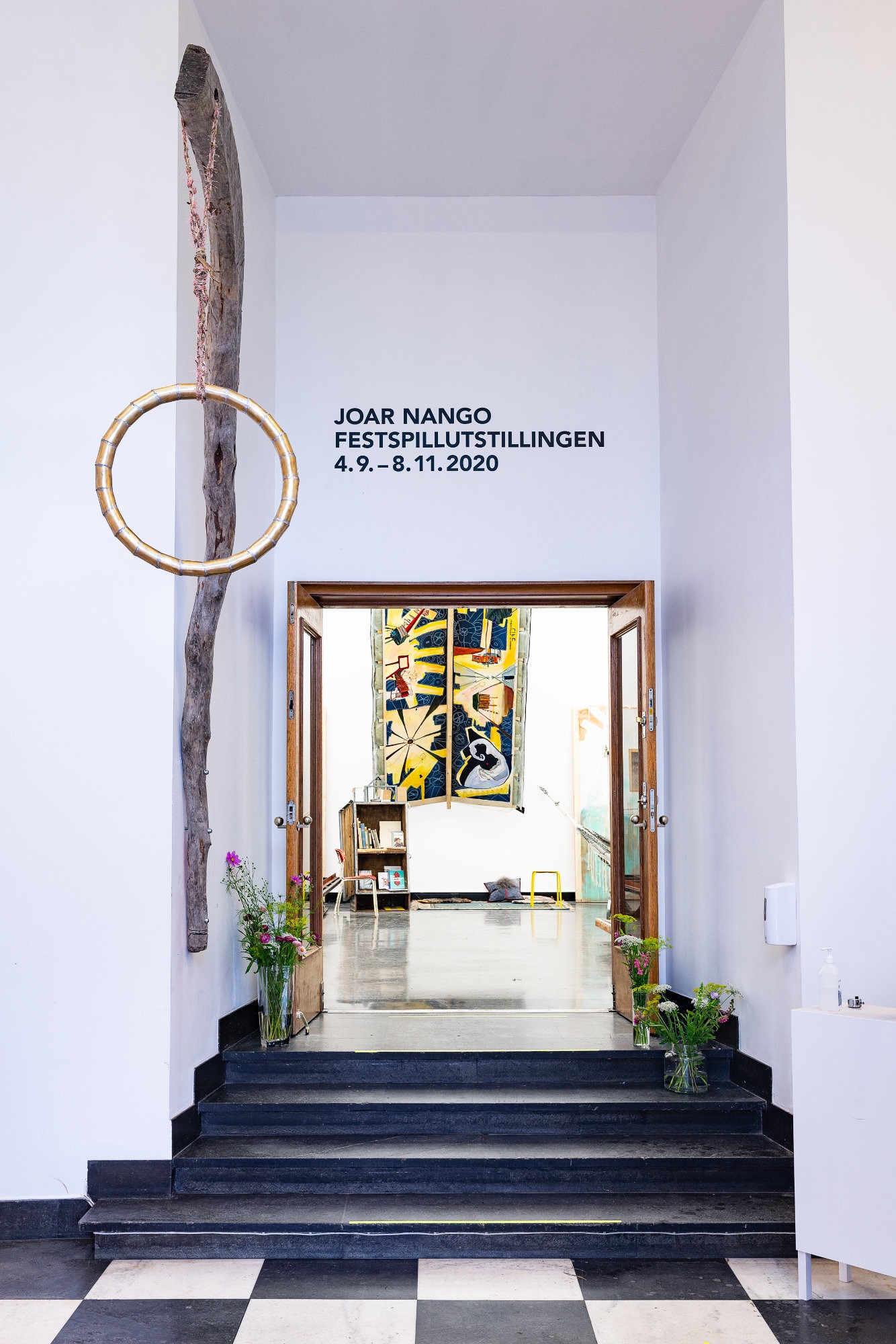
Installation view from Joar Nango ́s Festival Exhibition at Bergen Kunsthall. The same rope that hung you will pull you up in the end, 2020. Bealljit (bent birchpole), golden copper ring, rope made from reindeer hide and plastic fibre from firewood sack, 300 x 130 x 25 cm. Photo: Thor Brødreskift.

Installation view from Joar Nango ́s Festival Exhibition at Bergen Kunsthall. Girjegumpi (Sami Architecture Library), 2018–. Various dimensions. Wall painting: Anders Sunna. Duodji: Katarina Spiik Skum. Wood sculptures: Aqqalu Berthelsen. Hammock: MAKA design. Photo: Thor Brødreskift.
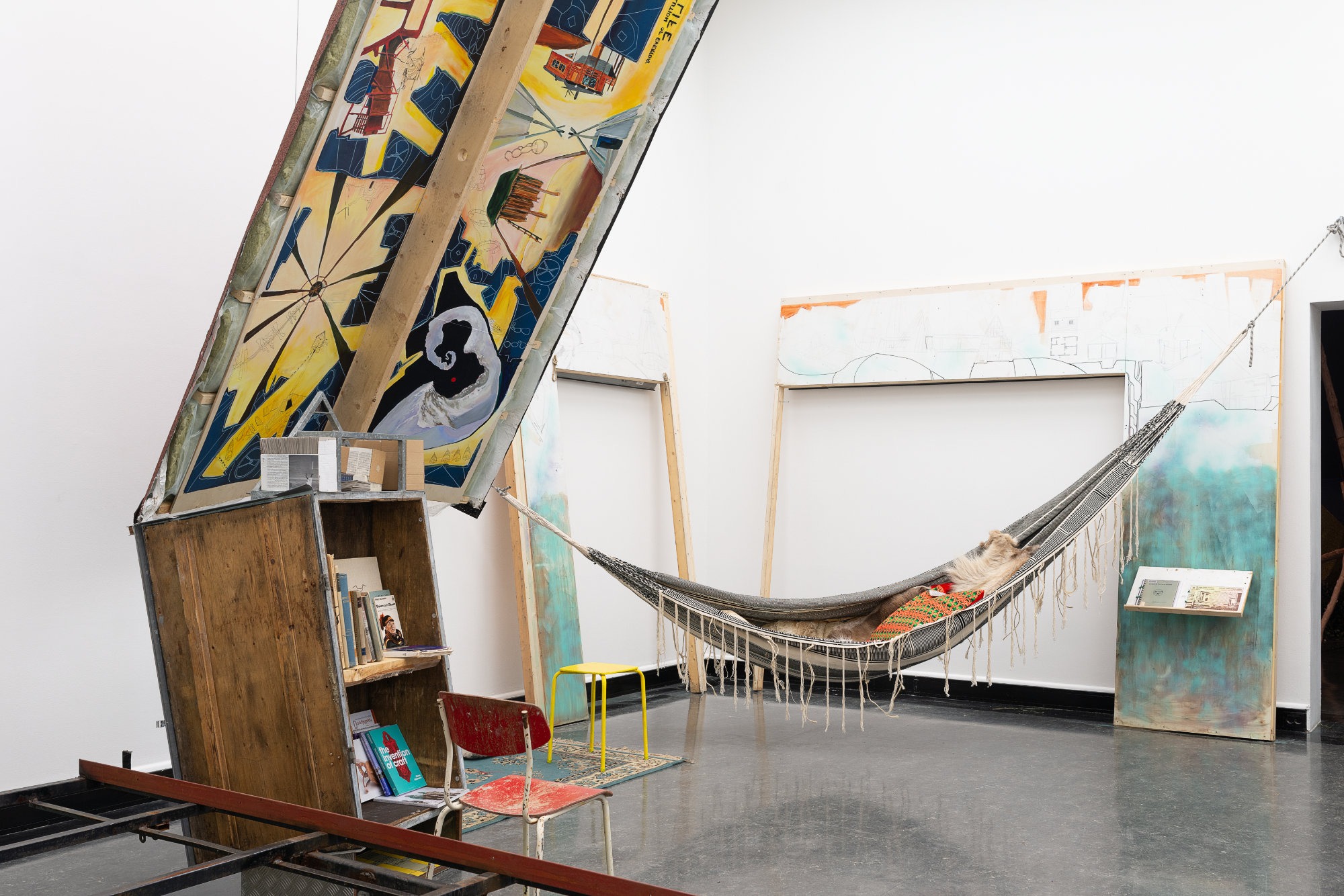
Installation view from Joar Nango ́s Festival Exhibition at Bergen Kunsthall. Girjegumpi (Sami Architecture Library), 2018–. Various dimensions. Wall painting: Anders Sunna. Duodji: Katarina Spiik Skum. Wood sculptures: Aqqalu Berthelsen. Hammock: MAKA design. Photo: Thor Brødreskift.
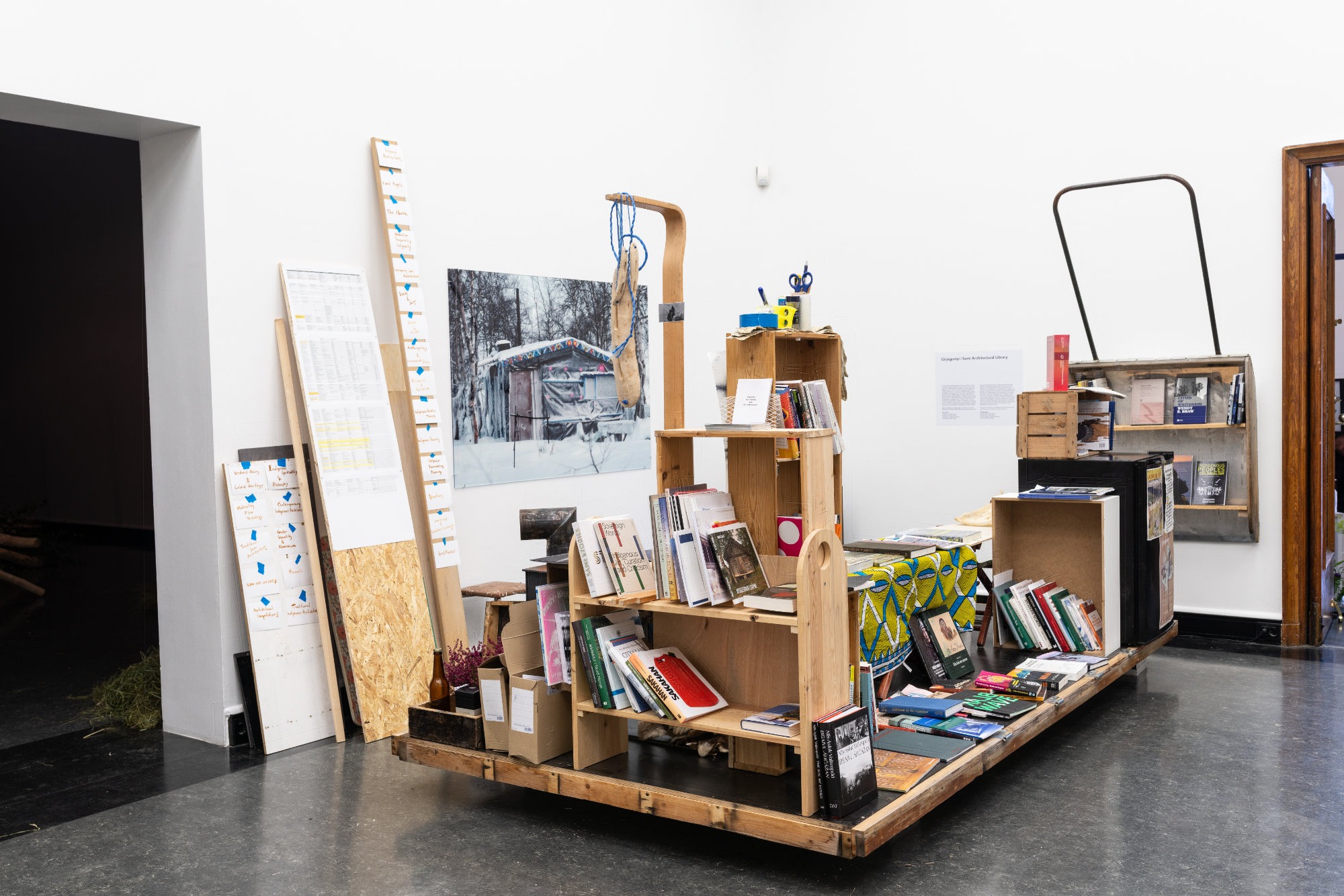
Installation view from Joar Nango ́s Festival Exhibition at Bergen Kunsthall. Girjegumpi (Sami Architecture Library), 2018–. Various dimensions. Wall painting: Anders Sunna. Duodji: Katarina Spiik Skum. Wood sculptures: Aqqalu Berthelsen. Hammock: MAKA design. Photo: Thor Brødreskift.
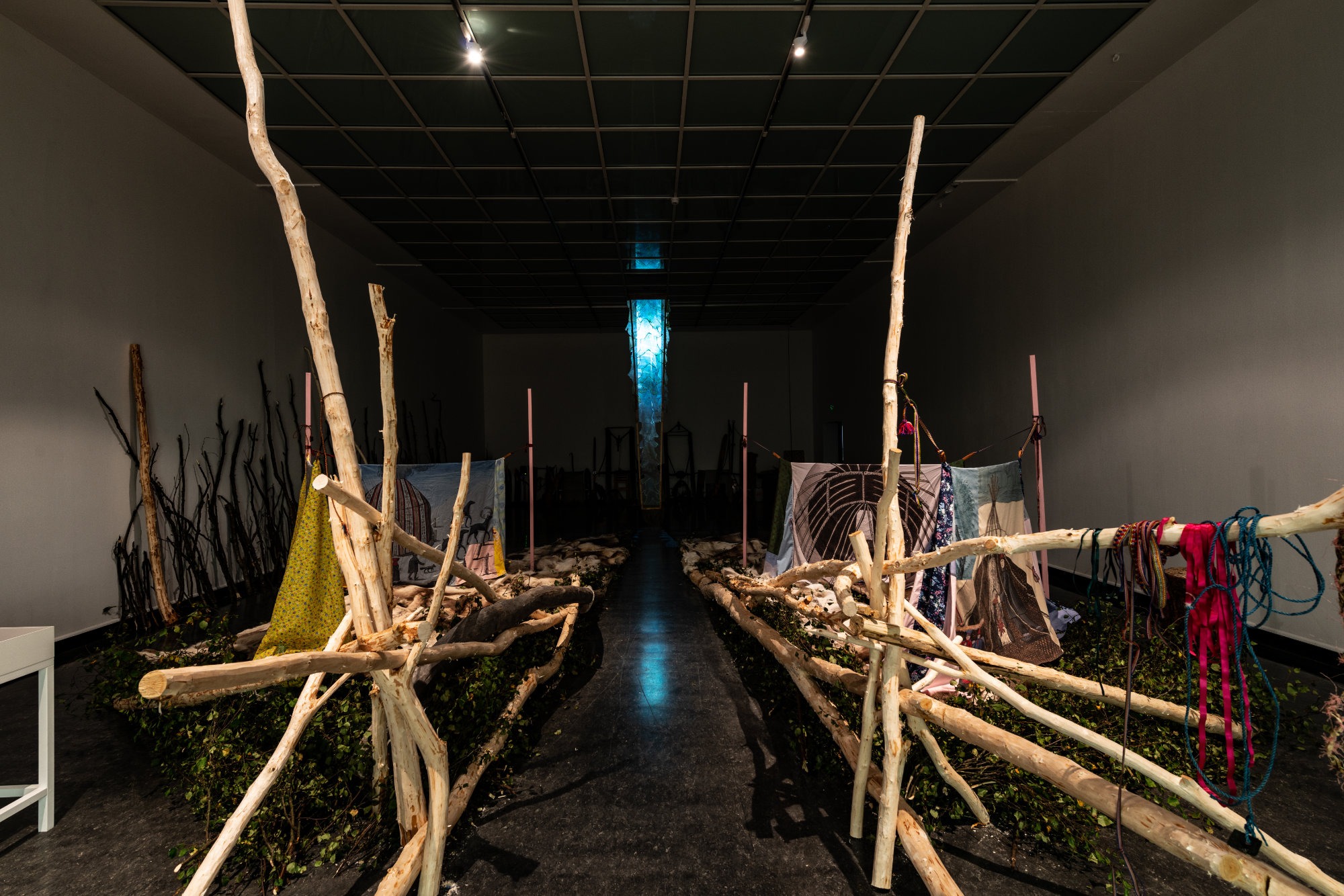
Installation view from Joar Nango ́s Festival Exhibition at Bergen Kunsthall. In the front: Rákkas 1–4, 2020 and in the back Skievvar, 2020. Photo: Thor Brødreskift.
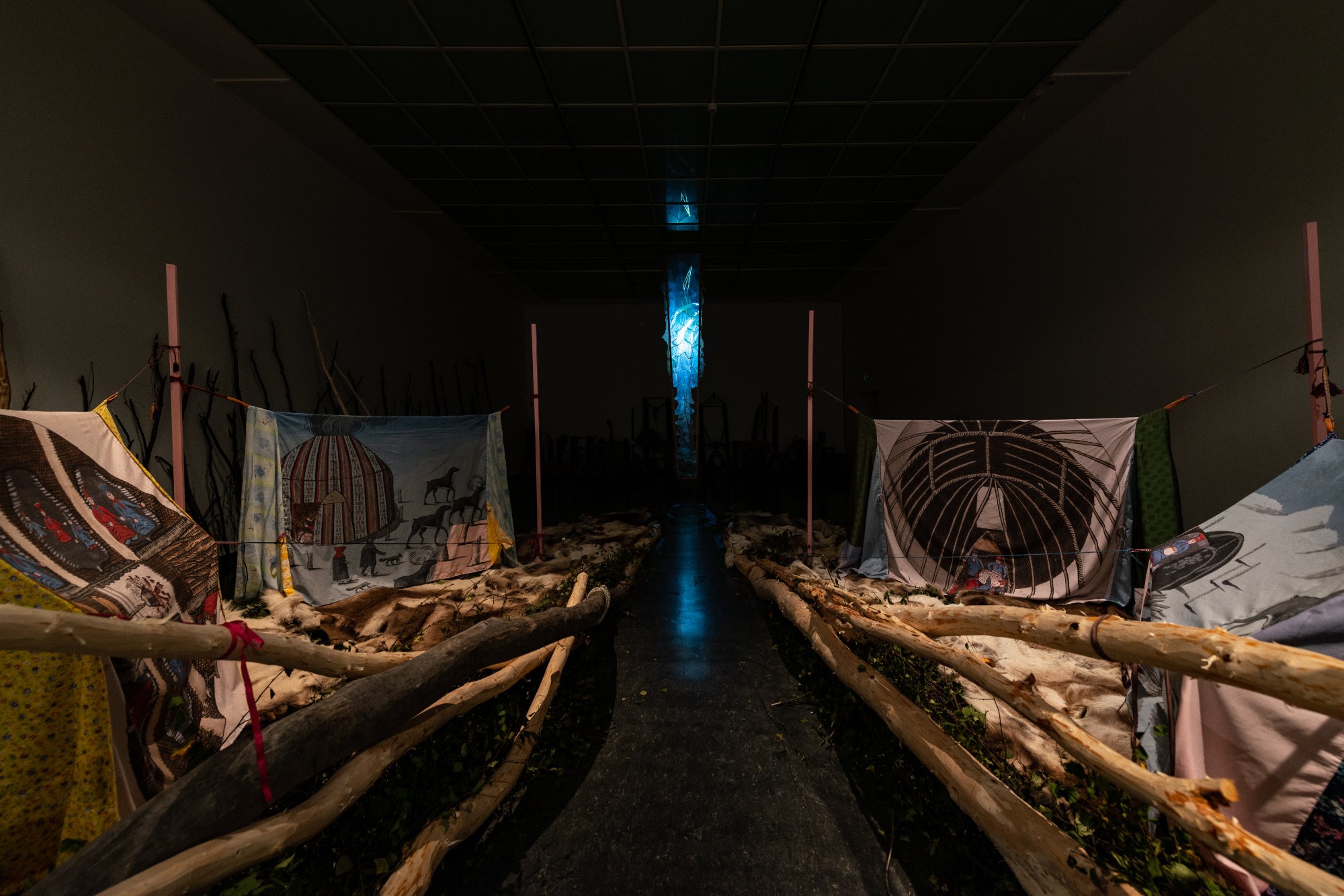
Installation view from Joar Nango ́s Festival Exhibition at Bergen Kunsthall. In the front: Rákkas 1–4, 2020 and in the back Skievvar, 2020. Photo: Thor Brødreskift.
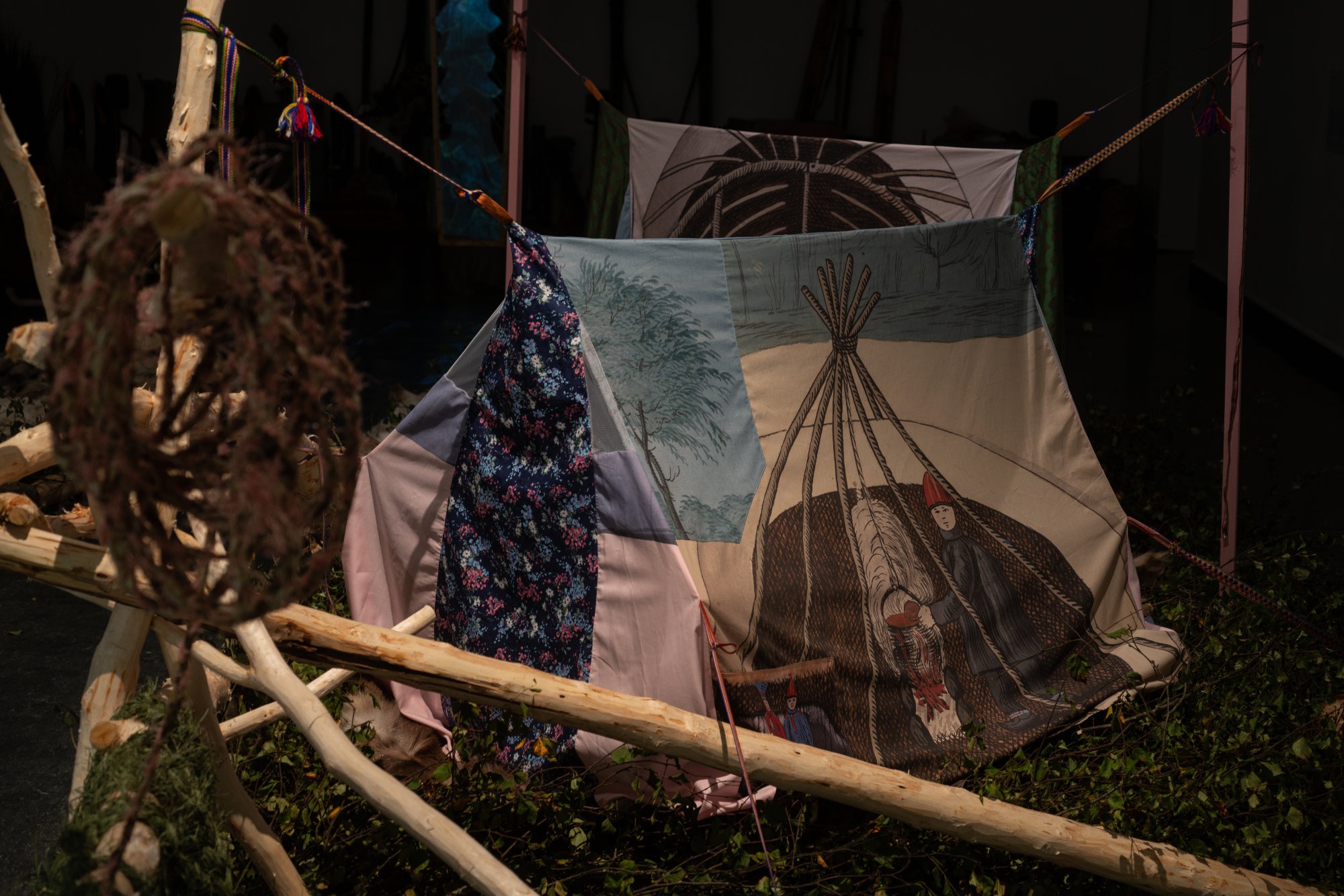
Installation view from Joar Nango ́s Festival Exhibition at Bergen Kunsthall. Rákkas 1–4, 2020. Color print on cotton. Various dimensions. Duodji: Katarina Spiik Skum. Photo: Thor Brødreskift.
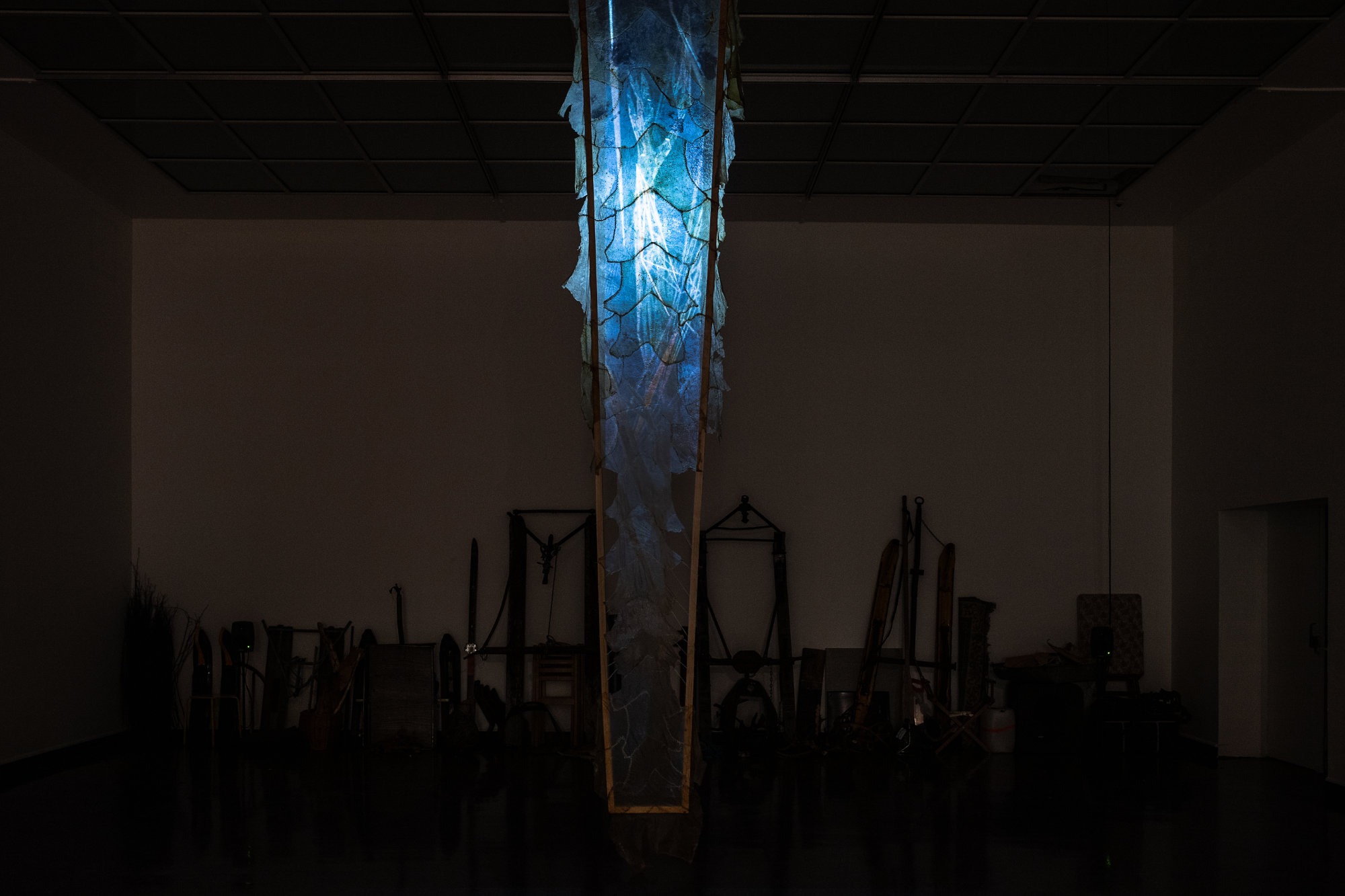
Installation view from Joar Nango ́s Festival Exhibition at Bergen Kunsthall. Skievvar, 2020. Halibut stomachs, wooden frame, tendon thread from reindeer, sound and video. Various dimensions. Video / 3D-animation: Markus Garvin. Sound: Alexander Rishaug. Skievvar screen: Ella Mørtsell, Vegard Urne, Rima Grybauskas, Håvard Arnhoff, Anna-Stina Svakko. Photo: Thor Brødreskift.
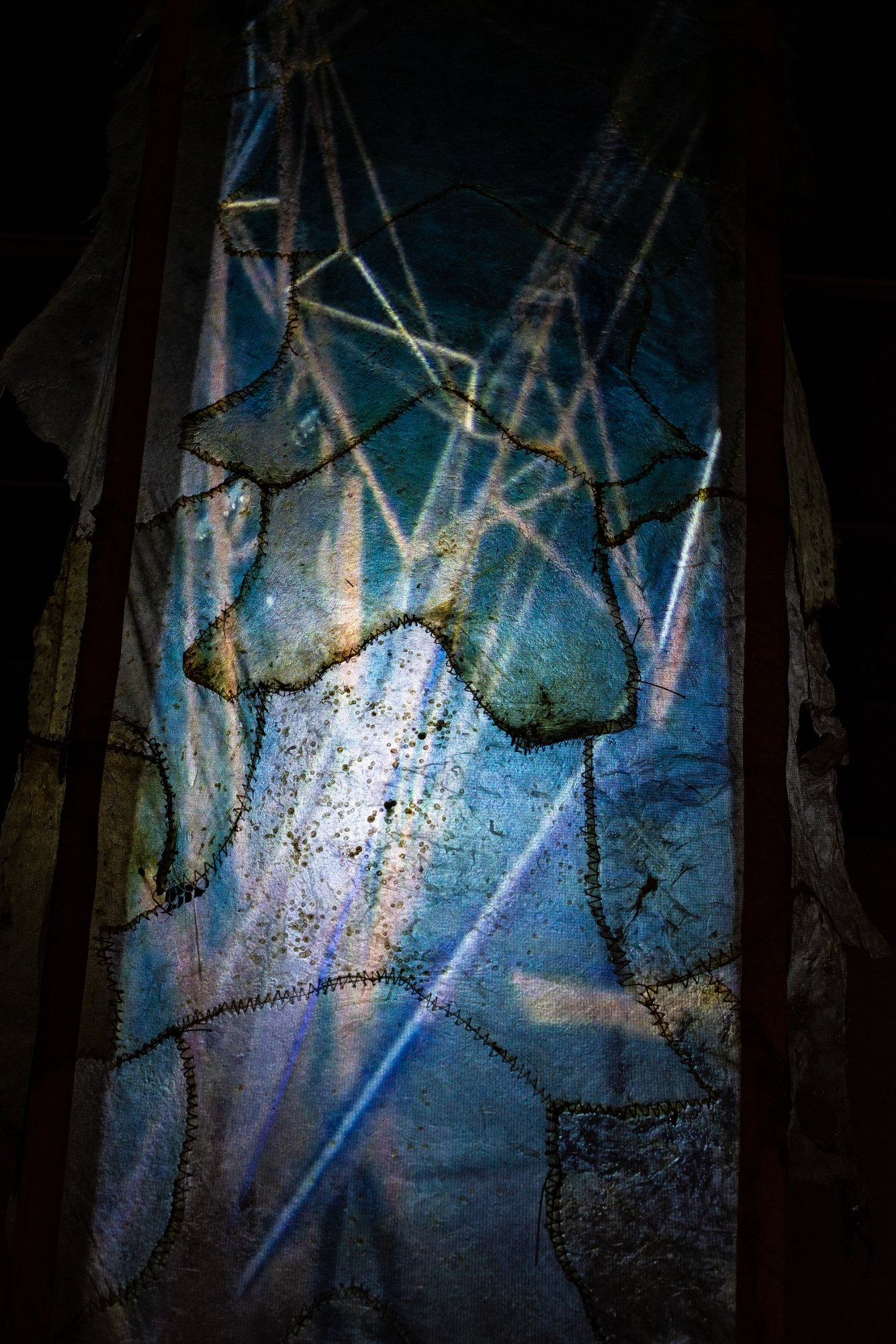
Installation view from Joar Nango ́s Festival Exhibition at Bergen Kunsthall. Detail of Skievvar, 2020. Photo: Thor Brødreskift.
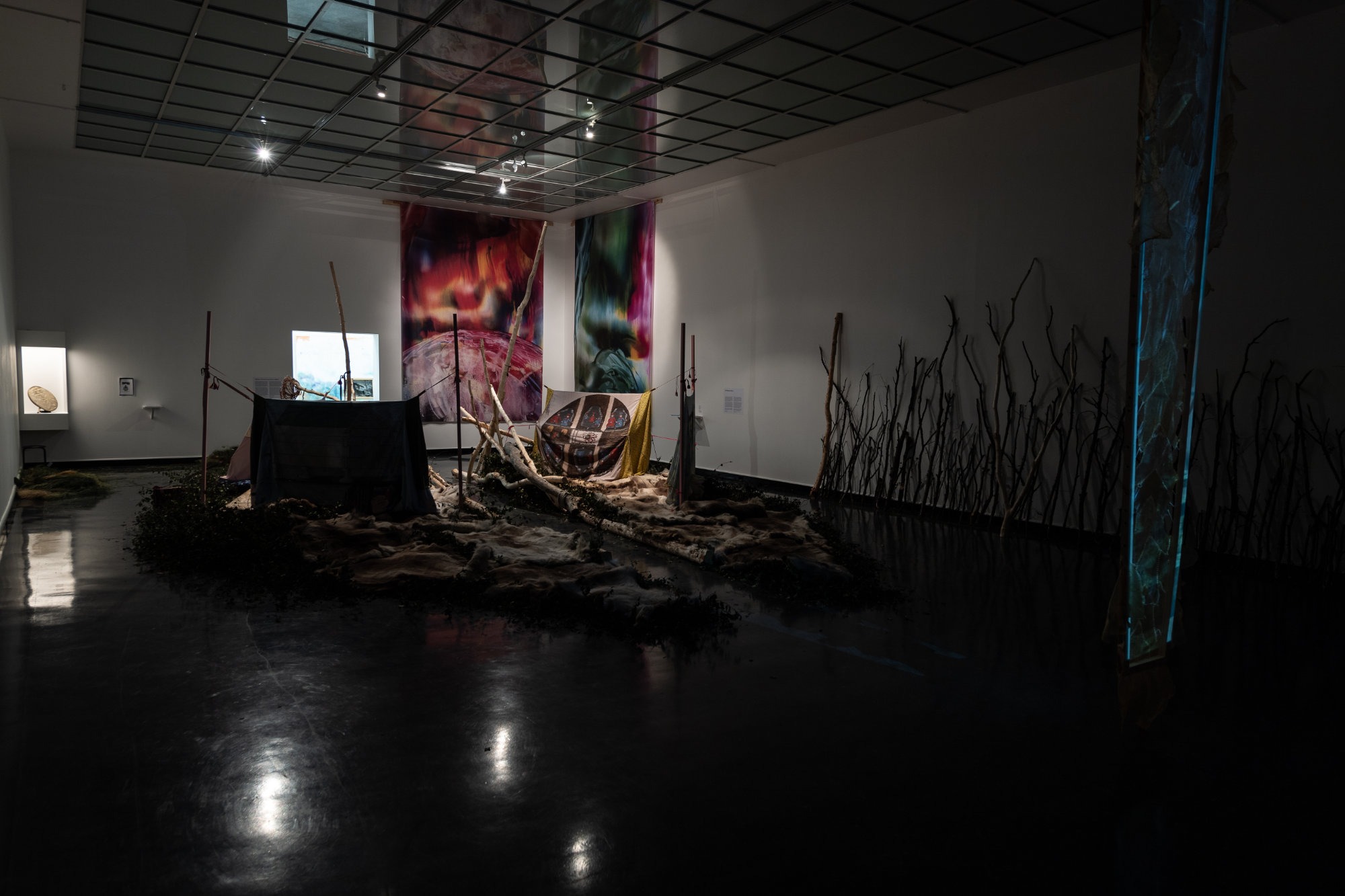
Installation view from Joar Nango ́s Festival Exhibition at Bergen Kunsthall. Photo: Thor Brødreskift.
The Festival Exhibition 2020 at Bergen Kunsthall presents Norwegian-Sámi artist Joar Nango. Initially trained as an architect, Nango constructs his exhibitions as laboratories, investigating traditions and experiences from his cultural background in Northern Norway, characterized by flexibility, pragmatism and adaptation to nature.
The exhibition will be less a finished product than an arena for a social process of creating places and situations with possibilities for improvisation and collective action. Nango’s work addresses indigenous identity and decolonialization, looking at these topics not in isolation, but as an expression of the ongoing dynamics between the so-called cultural centre and its peripheries.
The exhibition is based on a theoretical frame-work that Nango has set up together with collaborators from different artistic or academic backgrounds, including art historian Mathias Danbolt, writer Candice Hopkins and anthropologist Dimitris Dalakoglou. Following Nango’s ongoing investigations of the history of Sámi architecture, his library of books on the topic will be utilized in the exhibition, as well as a series of re-appropriated historical images from the 1700s. This series of hand-coloured drawings was made in the mid-1700s and is among the first known representations of Sámi architecture. In Nango’s exhibition, the images act as historical counterpoint, and a comment on the appropriation, circulation and representative power of images from indigenous cultures.
For a large-scale projection screen, Nango makes use of dried halibut stomachs that are sewn together. The technique, called skievvar in the coastal Sami tradition, is a way of making transparent windows in outhouses and simple buildings. Several of Joar Nango’s previous projects are brought to Bergen, and re configured for the exhibition, such as the girjegumpi, a small building made as a nomadic library inspired by the Sami gumpi, a herder’s hut mounted on sleigh runners. Nango’s van, a Mercedes Sprinter which was used in the project European Everything at Documenta 14 in 2017, will also be a central element in the Festival Exhibition. The physical infrastructure, and the travel itinerary between Bergen and Tromsø, form a geographical line between two site- specific landing points in the project. For European Everything he drove the same van from Tromsø to Athens – through the length of Europe – in an excursion in which themes of migration, relocation and the nomadic became a concrete experience. In May this year, the Sprinter doubled as a mobile TV studio during the production of Post-Capitalist Architecture TV.
A book will be co-published with Sternberg Press on the occasion of the exhibition, featuring new texts by Dimitris Dalakoglou, Mathias Danbolt, Candice Hopkins, Sigbjørn Skåden and Axel Wieder.
Joar Nango & Ken Are Bongo
Post-Capitalist Architecture TV
As a first chapter of the Festival Exhibition, Joar Nango made a three-part TV series together with Sámi filmmaker Ken Are Bongo, exploring Sámi architecture. The series was produced by Bergen Kunsthall as part of the Bergen International Festival in May 2020, which could not be held in a physical form due to the global Covid-19 pandemic. The series was filmed with a mobile TV studio during travels through the northern landscape, meeting guests for interviews and visiting key architectural sites.
With: Candice Hopkins, Elin Haugdal, Elin Már Øyen Vister, Dimitris Dalakoglou, Thora Petursdottir, Ande Somby, Lan Paulsen, Elle Márjá Eira, Mathias Danbolt, Chris Cornelius, Matti Aikio, Anders Rimpi, Alexander Rishaug, Taqralik Partridge, Liisa-Rávná Finnbog, Allessandro Petti, Per-Issát Juuso
The exhibition will be less a finished product than an arena for a social process of creating places and situations with possibilities for improvisation and collective action. Nango’s work addresses indigenous identity and decolonialization, looking at these topics not in isolation, but as an expression of the ongoing dynamics between the so-called cultural centre and its peripheries.
The exhibition is based on a theoretical frame-work that Nango has set up together with collaborators from different artistic or academic backgrounds, including art historian Mathias Danbolt, writer Candice Hopkins and anthropologist Dimitris Dalakoglou. Following Nango’s ongoing investigations of the history of Sámi architecture, his library of books on the topic will be utilized in the exhibition, as well as a series of re-appropriated historical images from the 1700s. This series of hand-coloured drawings was made in the mid-1700s and is among the first known representations of Sámi architecture. In Nango’s exhibition, the images act as historical counterpoint, and a comment on the appropriation, circulation and representative power of images from indigenous cultures.
For a large-scale projection screen, Nango makes use of dried halibut stomachs that are sewn together. The technique, called skievvar in the coastal Sami tradition, is a way of making transparent windows in outhouses and simple buildings. Several of Joar Nango’s previous projects are brought to Bergen, and re configured for the exhibition, such as the girjegumpi, a small building made as a nomadic library inspired by the Sami gumpi, a herder’s hut mounted on sleigh runners. Nango’s van, a Mercedes Sprinter which was used in the project European Everything at Documenta 14 in 2017, will also be a central element in the Festival Exhibition. The physical infrastructure, and the travel itinerary between Bergen and Tromsø, form a geographical line between two site- specific landing points in the project. For European Everything he drove the same van from Tromsø to Athens – through the length of Europe – in an excursion in which themes of migration, relocation and the nomadic became a concrete experience. In May this year, the Sprinter doubled as a mobile TV studio during the production of Post-Capitalist Architecture TV.
A book will be co-published with Sternberg Press on the occasion of the exhibition, featuring new texts by Dimitris Dalakoglou, Mathias Danbolt, Candice Hopkins, Sigbjørn Skåden and Axel Wieder.
Joar Nango & Ken Are Bongo
Post-Capitalist Architecture TV
As a first chapter of the Festival Exhibition, Joar Nango made a three-part TV series together with Sámi filmmaker Ken Are Bongo, exploring Sámi architecture. The series was produced by Bergen Kunsthall as part of the Bergen International Festival in May 2020, which could not be held in a physical form due to the global Covid-19 pandemic. The series was filmed with a mobile TV studio during travels through the northern landscape, meeting guests for interviews and visiting key architectural sites.
With: Candice Hopkins, Elin Haugdal, Elin Már Øyen Vister, Dimitris Dalakoglou, Thora Petursdottir, Ande Somby, Lan Paulsen, Elle Márjá Eira, Mathias Danbolt, Chris Cornelius, Matti Aikio, Anders Rimpi, Alexander Rishaug, Taqralik Partridge, Liisa-Rávná Finnbog, Allessandro Petti, Per-Issát Juuso
